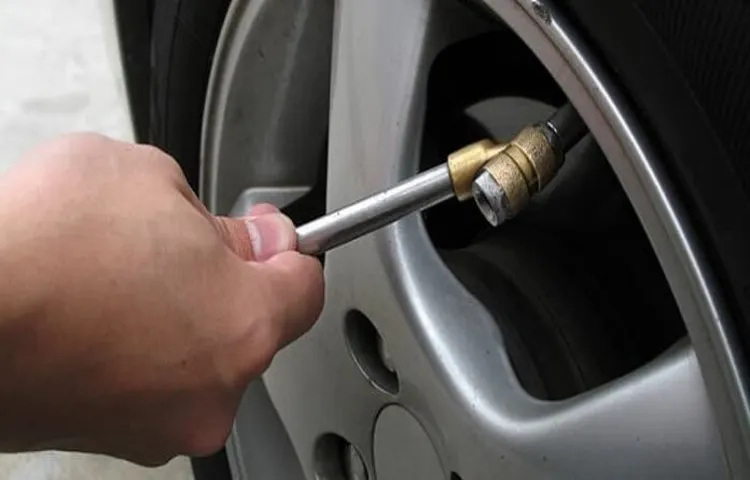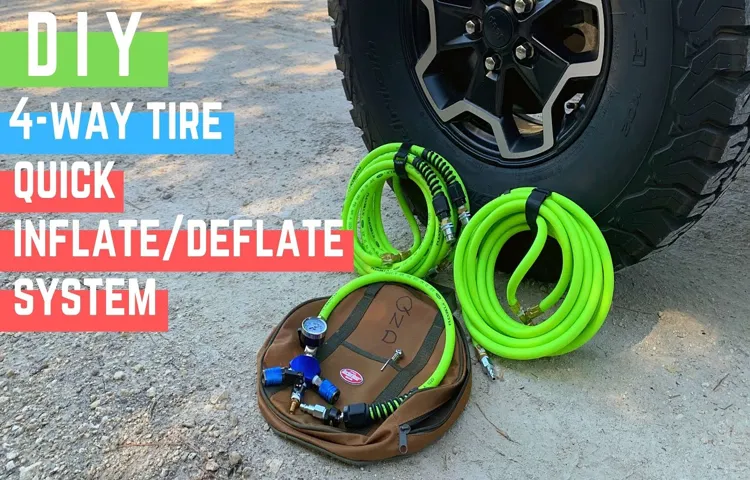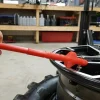Have you ever found yourself in a situation where you need to quickly deflate your tire? Maybe you need to adjust the pressure for off-roading, or your tire has a puncture and you need to urgently replace it. Whatever the reason may be, deflating your tire fast can be quite challenging and nerve-wracking if you are not familiar with the process. But don’t worry, in this blog, we will guide you through the steps of how to deflate a tire quickly and efficiently.
We understand that deflating your tire can be a tricky task, and doing it right is essential to avoid damaging your vehicle or hurting yourself. So, whether you are a seasoned mechanic or a beginner, we’ve got you covered. From the tools you will need to the correct procedure, we will cover everything you need to know in order to achieve a fast and effective tire deflation.
So sit back, grab a cup of coffee, and let’s dive into the world of deflating tires!
Tools Needed
If you’re planning to go off-roading, you should know how to deflate a tire fast. This essential skill allows you to adjust tire pressure for better traction on rugged terrain. The tools you will need for deflating a tire are quite simple.
A tire pressure gauge, tire deflator, and a valve stem remover are highly recommended. If you don’t have a tire deflator, a small screwdriver or valve core tool could also work. These tools can be found at most hardware or auto parts stores.
Deflating a tire is a simple process, but it’s crucial to remember to remove the valve cap first and to keep track of the tire’s pressure. It’s also essential to have a pump or air compressor on hand to inflate your tires back to the appropriate pressure when returning to paved roads. Overall, knowing how to deflate a tire fast is an important skill for any off-road enthusiast, and having the right tools ensures it’s done quickly and safely.
Example: Tire Pressure Gauge, Valve Core Removal Tool
When it comes to checking tire pressure, having the right tools is crucial. One important tool is the tire pressure gauge, which allows you to accurately measure the PSI of your tires. But what about when you need to add or remove air from the tire? That’s where the valve core removal tool comes in handy.
This tool allows you to quickly and easily remove the valve core, which is the small part inside the valve stem that controls the air flow. With the valve core removed, you can quickly add or release air from the tire as needed. When looking for tools to keep your tires in top condition, be sure to invest in a high-quality tire pressure gauge and valve core removal tool.
These tools will make it easy to keep your tires at the optimal pressure, which can improve their lifespan and performance.

Step-by-Step Process
If you need to deflate a tire fast, it is important to follow the proper steps to ensure that it is done safely and efficiently. First, locate the valve stem and remove the cap. Next, press down on the valve stem to release the air.
It is important to do this gradually, taking breaks in between to prevent the tire from bursting. Use a tire pressure gauge to check the pressure as you go. Once the tire is at the desired pressure, replace the valve stem cap.
It is important to note that while deflating a tire quickly may seem like a good idea, it can be dangerous and can cause the tires to become damaged. It is always best to take your time and do it properly to avoid any potential accidents or damage to your vehicle. Remember to always follow the manufacturer’s instructions for your specific vehicle.
Step 1: Remove Valve Cap
Removing the valve cap from your tire is the first step to ensuring that it stays in good condition for longer. It’s a simple task that should not take more than a few minutes, and it can go a long way in preventing flats and blowouts. To start, locate the valve cap on your tire, which will be a small plastic cap covering the valve stem.
Use your fingers to twist the cap counterclockwise and carefully remove it. It’s essential to be gentle when removing the cap, as forcing it can damage the valve stem, which will lead to leaks. Once you’ve removed the cap, set it aside in a clean and safe place, making sure not to lose it, as it will need to be replaced once you’re finished.
With your valve cap removed, you’re now free to proceed to the next step in maintaining your tire’s longevity.
Step 2: Press Valve Core
Once you have removed the valve cap, the next step in inflating your tire is to press the valve core. This can be done with a valve core tool or even with your fingernail in some cases. Simply press down on the valve core and hold it down while you attach your pump to the valve stem.
It’s important to make sure the valve core is pressed down firmly to prevent air from escaping while you inflate the tire. Once you’re ready to remove the pump, release the valve core and listen for the hiss of escaping air, indicating that the pressure has been released from the tire. By pressing the valve core correctly, you’ll be able to inflate your tire accurately and efficiently, ensuring a safe and smooth ride.
Remember, always check your tire pressure regularly and inflate as needed to maintain optimal performance and safety.
Step 3: Use Valve Core Removal Tool (Optional)
Valve Core Removal Tool Once you have located the valve stem of your tire, the next step in removing it is using a valve core removal tool. Though this step can be considered optional, it is still highly recommended to make the entire process of deflating the tire much easier and faster. Essentially, a valve core removal tool is a small device used to unscrew the valve core from the stem.
It is commonly used by tire professionals and DIY enthusiasts to deflate tires before repair, replacement, or storage. To use it, simply insert the tool into the valve stem and turn counterclockwise until the valve core loosens. Then, use your fingers to unscrew it and let the air out of the tire.
Once you have confirmed the tire is deflated, you can proceed with the upcoming procedure – be it tire repair, replacement, or storage. Remember that if you don’t have access to a valve core removal tool, you can still remove the valve core by using pliers, but it may take slightly more time and effort.
Step 4: Repeat Process for Other Tires (if necessary)
Now that you’ve successfully repaired one tire, it’s time to repeat the process for any other tires that may need attention. Start by inspecting the rest of your tires for any visible damage or signs of wear. If you notice any issues, use the same step-by-step process to address them.
Remember to check the tire pressure and fill them up to the recommended level before hitting the road. Keep in mind that proper tire maintenance is key to ensuring your safety and extending the lifespan of your tires. By taking care of them regularly, you can avoid costly replacements and enjoy a smoother, more reliable ride.
So don’t hesitate to repeat the process for all of your tires if necessary, and enjoy the peace of mind that comes with knowing your car is in top shape.
Tips for Faster Deflation
Deflating your tires is an important task when you need to adjust the air pressure, inflate them, or change the tires. While it might seem like a simple process, there are a few tips you can follow to make it faster and more efficient. First, make sure your car is in park and on a flat surface.
Then, remove the valve cap and press the valve stem with a tool or your fingers to release the air. If you’re in a rush, you can also use a valve stem removal tool to release the air even faster. Another tip is to move the tire around to help the air escape more quickly.
Remember to keep an eye on the pressure gauge so you don’t over-deflate your tires. By following these tips, you’ll be able to deflate your tires quickly and safely.
Tip 1: Use a Larger Valve Core Removal Tool
If you’re looking for quick and easy ways to deflate your tires, consider investing in a larger valve core removal tool. This handy tool makes the process of removing valve cores a breeze, allowing you to deflate your tires in seconds. With a larger tool, you won’t have to struggle with a small, hard-to-grip valve core remover, and you’ll be able to get the job done more efficiently.
Plus, you’ll be able to avoid the frustration and delay that can come from using inferior tools. Simply put, a larger valve core removal tool can help you get the job done faster and with less hassle, making it a worthwhile investment for anyone who wants to speed up the deflation process.
Tip 2: Park in a Cooler Area to Decrease Tire Pressure
deflation, tire pressure When it comes to deflating your tires for off-roading or other reasons, parking in a cooler area can actually be a helpful tip. That’s because heat expands air, so if you’re parked in a hot area, the air inside your tires will also expand, making it harder to release air and deflate them. By parking in a cooler area, you’ll have an easier time deflating your tires since the air inside them won’t be as expanded.
Additionally, remember that a lower tire pressure can make it easier to navigate off-road terrain, provide a smoother driving experience, and reduce the risk of punctures. So why not make things easier on yourself by parking in a cooler area and reducing your tire pressure more efficiently?
Tip 3: Release Air in a Zigzag Pattern
If you want to properly deflate your air mattress, releasing the air in a zigzag pattern can help speed up the process. This method involves applying pressure to the mattress while releasing the air in a back-and-forth motion, allowing for more air to escape at once. It may take a bit of practice to get the rhythm right, but once you do, you’ll notice a significant decrease in the amount of time it takes to deflate your mattress.
Another benefit of releasing the air in a zigzag pattern is that it removes more moisture from the mattress, preventing the growth of mildew and mold over time. So, the next time you need to deflate your air mattress, give the zigzag method a try and see how much faster and more efficient it can be!
Conclusion
In conclusion, deflating a tire quickly requires just the right combination of skill, technique, and a total disregard for your tire’s well-being. But if you’re looking for a truly speedy deflation, we recommend the tried-and-true method of operating a power drill on the tire’s valve stem. Just remember to hold on tight to that drill and wear some protective gear, because things are about to get wild and wacky!”
FAQs
What is the quickest way to deflate a tire?
Using a tire pressure gauge or a valve stem tool, remove the valve cap and press down on the valve stem to release air quickly.
Is it safe to deflate a tire quickly?
Yes, but it is important to monitor the tire pressure and not to deflate it below the manufacturer’s recommended levels.
Can I use a pump to quickly deflate a tire?
No, using a pump will not deflate a tire quickly. It is recommended to use a tire pressure gauge or valve stem tool.
What are the potential risks of deflating a tire too quickly?
Deflating a tire too quickly can cause a rapid decrease in air pressure, which can lead to a loss of control of the vehicle and even cause an accident. It can also damage the tire.
How long does it take to fully deflate a tire?
It depends on the size and type of tire, as well as the amount of air pressure that needs to be released. On average, it can take between 2-5 minutes to fully deflate a tire.
Is there a recommended way to deflate a tire safely?
Yes, it is recommended to deflate a tire slowly in increments of 5-10 PSI at a time while checking the pressure using a tire pressure gauge.
Can I use a flat-head screwdriver to deflate a tire?
It is not recommended to use a flat-head screwdriver as it can damage the valve stem. It is better to use a tire pressure gauge or valve stem tool.



